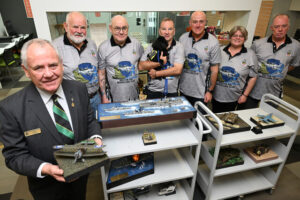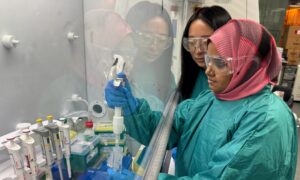Researchers at the University of Queensland have developed a groundbreaking microscopic wave tank that could revolutionize the study of fluid dynamics. This innovative device, designed at the School of Mathematics and Physics, utilizes a layer of superfluid helium just a few millionths of a millimetre thick on a chip smaller than a grain of rice.
Dr. Christopher Baker, who leads this research, describes the device as the world’s smallest wave tank. The unique properties of superfluid helium enable it to flow without resistance, unlike traditional fluids such as water that experience viscosity at these minuscule scales. Dr. Baker noted, “The study of how fluids move has fascinated scientists for centuries because hydrodynamics governs everything from ocean waves to the flow of blood and air through our bodies.”
What sets this project apart is the ability to generate and measure waves using laser light. This approach has led to the observation of various intriguing phenomena, including waves that lean backward instead of forward, shock fronts, and solitons that travel as depressions rather than peaks. Dr. Baker emphasized that while such exotic behaviors have been theorized, they had never been observed until now.
Transforming Fluid Dynamics Research
According to Professor Warwick Bowen, the chip-scale technology developed at the Queensland Quantum Optics Laboratory could significantly reduce the time required for experiments. The duration of data collection could be compressed by up to a million-fold, allowing what typically takes days to be completed in mere milliseconds. Professor Bowen explained, “In traditional laboratories, scientists use enormous wave flumes, sometimes hundreds of metres long, to study shallow-water dynamics like tsunamis and rogue waves, but these facilities only replicate a fraction of the complexities found in nature.”
The miniature device amplifies the nonlinearities that drive complex behaviors by more than 100,000 times. This capability allows researchers to study turbulence and nonlinear wave motion at a scale and precision previously unattainable. Professor Bowen remarked, “Being able to study these effects at chip scale with quantum-level precision could transform our understanding and modeling of fluid dynamics.”
The research opens a pathway to programmable hydrodynamics. The system’s geometry and optical fields are manufactured using techniques similar to those employed in semiconductor chip production. This allows for extraordinary precision in engineering the fluid’s effective gravity, dispersion, and nonlinearity. “Future experiments could uncover new laws of fluid dynamics and accelerate the design of technologies like turbines or ship hulls,” added Professor Bowen.
Broader Implications for Science and Technology
The implications of this research extend beyond theoretical physics. Experiments conducted on this tiny platform could enhance our ability to predict weather patterns, explore energy cascades, and investigate quantum vortex dynamics—questions that lie at the heart of both classical and quantum fluid mechanics.
The findings from this study have been published in the journal Science, and the project has received funding from the US Army Research Office and the Australian Research Council Centre of Excellence for Engineered Quantum Systems (EQUS).
The development of this microscopic wave tank represents a significant leap forward in fluid dynamics research, promising to unlock new avenues of scientific inquiry and technological advancement.







